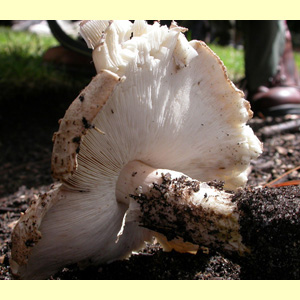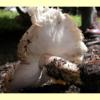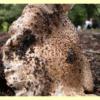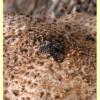
images/Lepiota_aspera/Lepiota_apsera_PG_FDSCN5285.jpg



Diagnostic characters
Medium to large agaric, growing on soil or on the ground, with a white or cream to yellow spore print. Pileus brown, rarely grey, not viscid; squamulose. Lamellae free. Stipe central. Partial veil remnants a membranous annulus. Spores hyaline, dextrinoid, smooth; germ pore absent. Cheilocystidia present. Lamellar trama regular. Pileipellis an epithelium; terminal elements globose to ovoid. Clamp connections present.
Similar genera
Lepiota aspera differs from other species of Lepiota in having an epithelial pileipellis. The pileus is densely scaly, and the scales can be conical as in Amanita, but in this genus the spores are amyloid or non-amyloid, not dextrinoid. In Chlorophyllum the spores usually have a germ pore and the pileipellis is occasionally an epithelium, but usually a trichoderm or a hymeniderm of subclavate or clavate elements.
Australian species
One species: Lepiota aspera (= L. revocans).
Citation of species
Lepiota aspera (Pers.) Quél., Enchir. Fung. 5 (1886).
Australian distribution
W.A., S.A., Qld and Vic. (and probably also N.T., N.S.W. and Tas.).
Habitat
In native forests or in parks and gardens.
Substrate
On the ground.
Trophic status
Saprotrophic.
References
Aberdeen, J.E.C. (1992), Lepiotoid Genera (Agaricales) in South-eastern Queensland. Aberdeen Publications, Gailes, Queensland. [Description, sketchy B&W Illustration and Microcharacters of L. aspera (as L. revocans)]
Breitenbach, J. & Kränzlin, F. (eds) (1995), Fungi of Switzerland. Volume 4. Agarics 2nd part. Edition Mykologia, Lucerne. [Illustration, Description and Microcharacters of L. aspera and several other closely related species of Lepiota from Europe with pileipellis an epithelium]
Fuhrer, B. (2005), A Field Guide to Australian Fungi. Bloomings Books, Hawthorn. [Description and Illustration of L. aspera]
Horak, E. (1980d), On Australasian species of Lepiota S.F.Gray (Agaricales) with spurred spores, Sydowia 33: 111–144. [B&W Illustration and Microcharacters of L. aspera]
